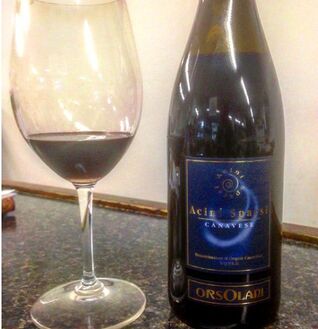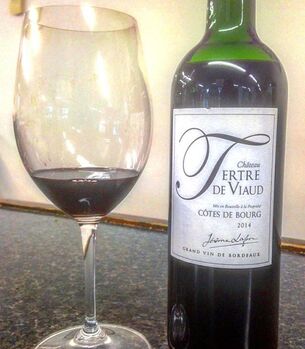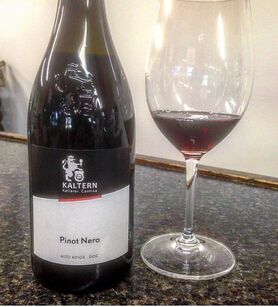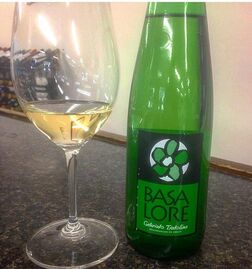 Most wine drinkers are familiar with the more 'civilized' images of vineyards, with neat orderly rows of vines divided block by block into precise sections, maximizing each varietal to its fullest potential. This is the path of the modern winery, deservedly so in many ways, as it eliminates a lot of random variables and helps to create a more consistent wine for the consumer. Before this level of detail came into being, many family vineyards were planted to a multitude of grape varieties, propagated from the neighboring vine when needed, resulting in parcels with a hodge-podge of grapes that could vary row to row and even vine to vine. Wines were usually made by harvesting the entire parcel all at once, usually without sorting out the different varieties and vinifying them separately, using an 'everybody into the pool' mentality. The healthier, more successful grapes would eventually make up a larger portion over time, but the wines made this way have a distinct personality that's built over time. California is famous for the largely Zinfandel-based wines made from these types of vineyards, with several wineries (Ridge, Ravenswood, Limerick Lane, and Bedrock to name but a few favorites) making their name on preserving some of the oldest and most cherished sites in the country. A little less known are the field blends in Italy, where old family plots abound and 'house wines' like this are pictures of days gone by. As a red wine from the Piedmont, this is primarily Barbera and Nebbiolo, which is to be expected. The unexpected comes fro the mix of other lesser red varietals that make their way to the tank in small amounts. Even a few dozen or so vines worth of white grapes make their way in, and make themselves immediately evident in the aroma with a peachy white citrus tone above the crunchy red fruits and black spices. The palate is silky and polished with lots of cranberry and higher toned red fruits, even a touch of apple skin tartness (probably also offered up from the white varieties in the mix), almost zesty and refreshing for a red wine. While not profound in any one way, it's definitely 'distinct' and deliciously enjoyable. Fans of wines like the long time store favorite Vajra Langhe Rosso (also from the Piedmont) will find a lot of kinship with this wine, and something fun to add to the weekly rotation.
0 Comments
 Even though the vineyards and the grapes don't change from vintage to vintage, the styles of Bordeaux can change fairly dynamically due to climate. Perhaps more than any other wine region consumers worldwide keep track of the weekly weather data, looking for long term trends that shape the final character of the wine and not just major events that make more obvious and dramatic impact. 2015 is considered very highly and there are a lot of great wines from that vintage, but is also a very warm year with lots of ripe wines that tend towards more naturally high alcohol levels (approaching and exceeding 14% in most cases). 2014 was cooler throughout that pushed the harvest well into the Fall, worrisome to many that the grapes would ripen well enough to make even decent wines, but saved by a warm dry September that got most vineyards over the finish line. The late and longer ripening process also created wines with less natural alcohol and darker natural fruit character, delivering many wines that would fall into a more 'classic' style of Bordeaux. Fans of these types of wines will be very happy with 2014, not the least of which being the hype machine won't drive up their prices the way 2015s may tend to be. Which is great because you may prefer this style anyway! Cabernet Sauvignon was the biggest beneficiary the the length and coolness of the 2014 vintage, and even though it makes up only about 20% of this blend, it plays a pretty distinctive role. Lots of cool currant, black cherry skin and pencil lead aromas with a slight tinge of cedar even though there is no oak aging involved here. The texture is delightfully polished with very fine natural tannins that hold the wine together quite nicely, if anything the oak would have dried out the wine a little too much. Savory fruit fills the mouth without feeling thick or saturated, sitting just on the edge of ripeness without any green notes, pushing all the way through the lively earthy finish. A classic dinner wine that doesn't need any extra time to cellar, tasting and feeling surprisingly ready to go without a whole lot of time open.  We have always organized the wine in our store based on region and country, believing strongly in the idea that where the wine is from, its 'terroir' and the culture, is one of the largest factors if not THE largest in determining the character of the wine. Where it sometimes fails us is when there are great varietal wines from an outlying area, somewhere that isn't famous for making wines from X grape so we may only have 1-2 examples. When people are looking for Pinot Noir, they gravitate towards the classic areas of Burgundy, California, and Oregon to browse through dozens of examples. Alto Adige? Italy? Never crosses most people's minds. But it should, and we need to direct more people over there to find it. The grape does have a strong history here in the cool mountain region, perhaps not to the great heights of quality as Burgundy, but as a solid and consistent daily drinker, which is what more Pinot Noir fans hope to find these days. Built with more of an Old World style in mind, this only sees a little bit of time aged in oak, mostly stored in concrete tanks to allow the natural fruit and savoriness of the grape to shine through, and also lets the wine show deliciously from the very first pour. Dark cherry skin aromas and pomegranate pop from the glass immediately, with a background hint of earthy stems and clove that gives a nod to some time honored Burgundian characters. The palate shows more body than expected without sweetening the fruit flavors at all, balancing the feather soft tannins with a lively acidity that prickles the mouth. While this would never be confused with a blockbuster Cru Bourgogne, it would marry perfectly with some weekday dining that features something like lentils or wild mushrooms, something rustic and easy. Priced right so you don't have to make a big deal about opening it.  The Basque portion of Spain stands historically separate from most of Spain, both geographically and politically. Their culture and cuisine are world famous, but generally do not get as aggressively marketed and distributed around the world the way other parts of Spain do, and the wine is affected by that as well. So much of the local wines get consumed locally in the thriving dining culture around Bilbao and San Sebastian, you just don't see that many value versions, just a handful of elite producers whose wines aren't terribly expensive but do make the more casual drinker pause. Thankfully there are starting to be a few reasonably priced stars emerging like this one, giving consumers a chance to try wines from grapes like Hondarribi Zuri and the like. In concept, this is the cultural twin to Muscadet in the French Loire; racy, clean and simple, built to compliment and not take center stage on its own. Pouring with a slight pinprick of SO2 bubbles, even less so than your typical Vinho Verde, the aromas are all green apples and fresh cut limes, perhaps even a hint of sea spray when the wine is a bit cooler. The palate is juicy and wet, a bit neutral on the first sip but builds the lime zest and crisp apple flavors the longer it sits in the mouth. The slight prickle from the gas hits the palate as well to pump up the zestiness, but dissipates within 10 minutes or so to give the wine a softer finish over time. Being under 12%abv one would think this could be containing some residual sweetness somewhere, but the grape ripens with low sugars naturally so this is delightfully dry throughout. One of the great food matches when paired with oily seafood dishes, sardines, octopus, and the like. |
The Best of the Best.We offering free tastings on these wines in the store every Thursday and Friday, and a 10% discount off the retail price through the duration of the day. Come on by and give them a try! Archives
July 2024
Categories |
Location |
|

 RSS Feed
RSS Feed